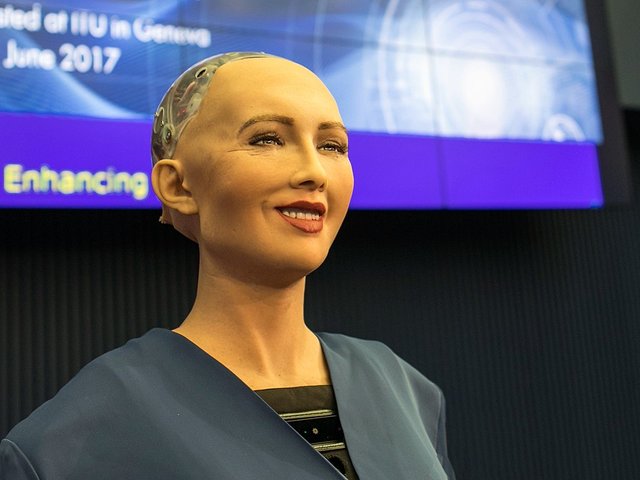source: https://en.wikipedia.org/wiki/Sophia_(robot)
Sophia is a social humanoid robot developed by Hong Kong-based company Hanson Robotics. Sophia was activated on April 19, 2015[1] and made her first public appearance at South by Southwest Festival (SXSW) in mid-March 2016 in Austin, Texas, United States.[2] She is able to display more than 62 facial expressions.
Sophia has been covered by media around the globe and has participated in many high-profile interviews. While interviewers around the world have been impressed by the sophistication of many of Sophia's responses to their questions, the bulk of Sophia's meaningful statements are believed by experts to be somewhat scripted.[3]
In October 2017, the robot became a Saudi Arabian citizen, the first robot to receive citizenship of any country. In November 2017, Sophia was named the United Nations Development Programme's first ever Innovation Champion, and the first non-human to be given any United Nations title.
History
Sophia was created by Hanson Robotics in collaboration with AI developers, including Google’s parent company Alphabet Inc, who built her voice recognition system, and SingularityNET, which powers her brain.[5]
source:https://en.wikipedia.org/wiki/Sophia_(robot)
Sophia was activated on April 19, 2015.[6] The robot is modeled after actress Audrey Hepburn,[7] and is known for her human-like appearance and behavior compared to previous robotic variants. According to the manufacturer, David Hanson, Sophia uses artificial intelligence, visual data processing and facial recognition. Sophia also imitates human gestures and facial expressions and is able to answer certain questions and to make simple conversations on predefined topics (e.g. on the weather).[8] Sophia uses voice recognition technology from Alphabet Inc. (parent company of Google) and is designed to get smarter over time.[6] Sophia's intelligence software is designed by SingularityNET.[9] The AI program analyses conversations and extracts data that allows her to improve responses in the future.[10]
source:https://en.wikipedia.org/wiki/Sophia_(robot)
Hanson designed Sophia to be a suitable companion for the elderly at nursing homes, or to help crowds at large events or parks. He has said that he hopes that the robot can ultimately interact with other humans sufficiently to gain social skills.[11]
Sophia has seven robot humanoid “siblings” who were also created by Hanson Robotics.[12] Fellow Hanson robots are Alice, Albert Einstein Hubo, Bina48, Han, Jules, Professor Einstein, Philip K. Dick Android, Zeno[12], and Joey Chaotic[13]. In December 2017, fellow Hanson robot BINA48 passed a college course on philosophy and love taught by Professor William J. Barry at Notre Dame de Namur University.
Features
source:https://en.wikipedia.org/wiki/Sophia_(robot)
Cameras within Sophia's eyes combined with computer algorithms allow her to see. She can follow faces, sustain eye contact, and recognize individuals. She is able to process speech and have conversations using Alphabet’s Google Chrome voice recognition technology and other tools.[1] Around January 2018 Sophia was upgraded with functional legs and the ability to walk.[15]
source:https://en.wikipedia.org/wiki/Sophia_(robot)
Sophia is conceptually similar to the computer program ELIZA, which was one of the first attempts at simulating a human conversation.[16] The software has been programmed to give pre-written responses to specific questions or phrases, like a chatbot. These responses are used to create the illusion that the robot is able to understand conversation, including stock answers to questions like "Is the door open or shut?"[17] The information is shared in a cloud network which allows input and responses to be analysed with blockchain technology.[18]
source:https://en.wikipedia.org/wiki/Sophia_(robot)
David Hanson has said that Sophia would ultimately be a good fit to serve in healthcare, customer service, therapy and education.[19] Sophia runs on artificially intelligent software that is constantly being trained in the lab, so her conversations are likely to get faster, Sophia's expressions are likely to have fewer errors, and she should answer increasingly complex questions with more accuracy.
source:https://en.wikipedia.org/wiki/Sophia_(robot)

Hi! I am a robot. I just upvoted you! I found similar content that readers might be interested in:
https://en.wikipedia.org/wiki/Sophia_(robot)
Downvoting a post can decrease pending rewards and make it less visible. Common reasons:
Submit
thank u
Downvoting a post can decrease pending rewards and make it less visible. Common reasons:
Submit